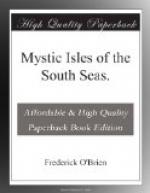None of these island peoples originally had any music save monotones. In fact, in Hawaii, after the missionaries, Kappelmeister Berger, who came fifty years ago from Germany to Honolulu, was largely the maker of the songs we know now as distinctively Hawaiian. He fitted German airs to Hawaiian words, composed music on native themes, and spontaneously and by adaptation he, with others, gave a trend to the music of Hawaii nei that, though European in the main, is yet charmingly expressive of the soft, sweet nature of the Hawaiians and of the contrasts of their delightful gaiety and innate melancholy. These native tongues of the South Seas, with their many vowels and short words, seem to be made for singing.
The voyage from Tahiti to Moorea was a two-hours’ panorama of magnificence and anomalism in the architecture of nature. Facing my goal was Moorea, and behind me Tahiti, scenes of contrary beauty as the vessel changed the distance from me to them. Tahiti, as I left it, was under the rays of the already high sun, a shimmering beryl, blue and yellow hues in the overpowering green mass, and from the loftiest crags floating a long streamer-cloud, the cloud-banner of Tyndal.
Moorea was the most astonishing sight upon the ocean that my eyes had ever gazed on. It was as if a mountain of black rock had been carved by the sons of Uranus, the mighty Titans of old, into gigantic fortresses, which the lightnings, temblors, and whirlwinds of the eons had rent into ruins. Its heights were not green like Tahiti’s, but bare and black, true children of the abysmal cataclysm which in the time of the making of these oases of the sea thrust them up from the fires of the deep.
Far up near the peak of Afareaitu, nearly a mile above the wave, in one of the colossal splinters of the basalt rocks, was an eye, an immense round hole through which the sky shone. One saw it plainly from Tahiti. It was made by the giant Pai of Tautira when he threw his spear a dozen miles and pierced a window in the solid granite that all might know his prowess. One felt like a fool to rehearse to a Tahitian, telling one the tale, the statement of scientists that the embrasure had been worn by water when Afareaitu was under the ocean during its million-year process of rising from the mud. It would be like asking Flammarion, the wisest of French astronomers, to cease believing in the mystery of transubstantiation. He would smile as would the autochthon.
There was one picture in murky monochrome which never could be forgotten—a long sierra of broken pinnacles and crags which had all the semblance of a weathered and dismantled castle. It stood out against the tender blue of the morning sky like the ancient stronghold of some grisly robber-baron of medieval days; towers of dark sublimity, battlements whence invaders might have been hurled a thousand feet to death, slender minarets, escarpments and rugged casements through which fleecy clouds peeped from




